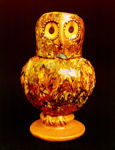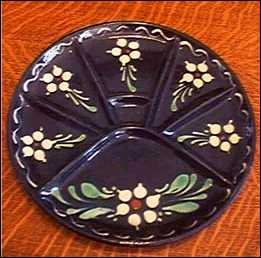|
 Slip trailed decoration reached its peak in popularity
during the reign of Charles II. The
Toft family produced especially fine
slipware - usually large platters of red clay, which were covered in white slip
and then trailed with decoration, very often featuring the royal family,
mermaids and pelicans. Slip trailed decoration reached its peak in popularity
during the reign of Charles II. The
Toft family produced especially fine
slipware - usually large platters of red clay, which were covered in white slip
and then trailed with decoration, very often featuring the royal family,
mermaids and pelicans.
 Feathering and marbling were also carried out using
slip, such as the owl shown below: Feathering and marbling were also carried out using
slip, such as the owl shown below:

Ozzy the owl
a North Staffordshire slipware owl jug
 on Ozzy
on Ozzy
 Slip painting was widely used in ancient Egyptian
pottery, in which animal and scenic motifs are painted in white slip on a red
body, and in North American Indian wares. Another form of slip decoration is the
piping on of trails of slip in the manner of cake icing, so that a design is
achieved in lines of colour (often white) contrasting with the body of the
vessel. Further moulding of the applied slip may be carried out or small blobs
of slip dropped on and then moulded or stamped with a raspberry, rosette, or
other shape. Slip painting was widely used in ancient Egyptian
pottery, in which animal and scenic motifs are painted in white slip on a red
body, and in North American Indian wares. Another form of slip decoration is the
piping on of trails of slip in the manner of cake icing, so that a design is
achieved in lines of colour (often white) contrasting with the body of the
vessel. Further moulding of the applied slip may be carried out or small blobs
of slip dropped on and then moulded or stamped with a raspberry, rosette, or
other shape.
 Dotted and trailed slip decoration was probably never
so well executed as in 17th-century England, where the North
Staffordshire potters depicted human and animal figures, stylised flowers, and
fluid linear patterns. The technique demanded great dexterity and control. Dotted and trailed slip decoration was probably never
so well executed as in 17th-century England, where the North
Staffordshire potters depicted human and animal figures, stylised flowers, and
fluid linear patterns. The technique demanded great dexterity and control.

This old stoneware plate is glazed in cobalt blue
with
a fine slipware design in cream, mint, and rust.
It measures 10 1/8" and is quite heavy and
thicker than your typical plate.
|